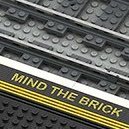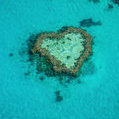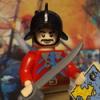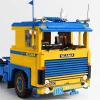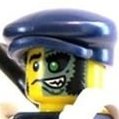Search the Community
Showing results for tags 'japan'.
Found 39 results
-
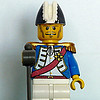
[MOC] Mizugami no jinsha - Shrine of the water god
the Inventor posted a topic in LEGO Historic Themes
Deep in the mountains lies a small shrine of the water god on the edge of a lake between the blooming cherry trees. Mizugami no jinsha - Shrine of the water god by Ids de Jong, on Flickr Temple and torii gate - close up by Ids de Jong, on Flickr Thanks for looking, C&C always welcome. -
Shiromaruhime is the Himeji City Mascot. In November 2023 I visited Himeji Castle in Japan. It inspired me to build this LEGO creation of the Himeji City Mascot: Here are some pictures of Shiromaruhime: On the pictures of Shiromaruhime the castle roof is very simplistic. I wanted to build the castle roof with more details. Therefore, I built it based on how it looks in real life:
-
What to do in Japan, right, visit a combini. This small convenience store has familiar colours, but apparently is not related to some famous multinational chain of retail convenience stores. Combini by Ids de Jong, on Flickr
-
I shared the 1st to 3rd floor in the past. Now, let me share the 4th floor. It is my dream, Lego studio. I always want to own a LEGO studio, but I don't think I can achieve that in the foreseeing future. So I put my dream on the 4th floor. The studio has a LEGO storage parts wall, a Lego city layout, and a working station for taking pictures or videos. Welcome to check out the video: More MOC on my homepage: https://www.bricksboy.com/moc
-
- modular building
- japan
-
(and 5 more)
Tagged with:
-
MOC#94-2 Sushi Restaurant, Japan Office Building 2nd Floor I already showed the 1st-floor 7-Eleven in the previous post. This post is for the sushi restaurant on the 2nd floor. I also created the video to show you the detail: More MOC on my homepage: https://www.bricksboy.com/moc
- 5 replies
-
- restaurant
- sushi
-
(and 3 more)
Tagged with:
-
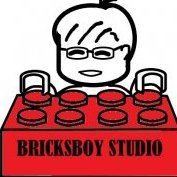
[MOC]#94-1 7-Eleven Convenience Store, Japan Office Building 1st Floor
bricksboy posted a topic in LEGO Town
LEGO MOC#94-1 7-Eleven Convenience Store, Japan Office Building 1st floor, レゴセブン-イレブンコンビニ, 樂高7-11便利店 I have designed a four floors office building in Japanese style. I am going to introduce each floor one by one in separate posts. This post is to show the 7-Eleven convenience store on the 1st floor. The slide doors at the entrance can be opened and closed by turning the gear on the top. I also created a stop-motion video to demonstrate the detail of this build. Welcome to take a look: More MOC on my homepage: https://www.bricksboy.com/moc -
Typical Japanese castle Inspired by: Himeji Castle in Japan (completed in 1618) This building is a part of a series of 21 buildings built in different architectural styles. Each building is built on one 32x32 baseplate: https://www.flickr.com/photos/66344850@N06/albums/72157708211032315
- 3 replies
-
- architecture
- japan
-
(and 1 more)
Tagged with:
-
The Sacred Bridge, leading to the Inari shrine. The Kitsune (https://en.wikipedia.org/wiki/Kitsune) is drinking by the river. And many animals are observing the traveling monk, while he walks on the sacred bridge leading to the shrine. The blue birds are supposed to be Red-flanked bluetails, and the other bird is a Japanese Crane (Red-crowned Crane). Inspiration for this build, is the various red Japanese bridges leading to a shrine or other sacred place, this one was based on the Shinkyo Bridge leading to the Futarasan Shrine in Nikko, which I visited in 2020. Build for the Summer Joust 2022 'Bridging the Gap' category. The Sacred Bridge by Ids de Jong, on Flickr
- 12 replies
-
- japan
- summer joust
- (and 6 more)
-
This is my LEGO version of the Kyushu Line JR800 Shinkansen, made of 5.959 pieces, having a length of 2,74m (9ft) and weights 4,302kg (9.484 pounds) in total and is my first train MOC. The 800 Series, designed by Mr. Eiji Mitooka, is considered the only "Japanese" shinkansen as it's concept represents the beauty of Japanese arts and crafts, and has two engines and four wagons. The train went in service in 2009 and is considered the second fastest of the 3 JR Kyushu types of Shinkansen services (the rest are Mizuho and Tsubame, from the fastest to slowest). Update 09.05.22 (The Previous Content can be found within the hidden content area, at the bottom of this post) You can find more pictures on my FlickR and enjoy it on the following video;
- 27 replies
-
Island Shrine After multiple trips, there's only one place in Japan I went back to on every occasion I had: Eikan-dō Zenrin-ji temple in Kyoto. The garden, the colors, the view from the mountain side, and that lake. This place made me feel so remote and calm... This is my attempt to convey this. This MOC is only inspired by the view I remember, not aiming to be accurate at all and taking only a few details from other shrines elsewhere. Album Island Shrine on Flickr There are a few illegal connections here and there, but I don't care, I was aiming for the looks. For instance, I wanted the torii to have slightly angled pillars. As for the build, it all started with the candle stand and the bridge. I then built and rebuilt the island and shrine multiple times, before moving on to actually setting up the bridge and shore. Work in progress pictures can be found there: https://imgur.com/a/kseldcB. It's my very first MOC ever, it took a lot of time, trial and error, but I'm proud of the result and would gladly take some advice if you have some. I submitted it to the Summer Joust 2021, "asian setting" category, as it was still open for entries when I uploaded this to flickr yesterday. I hope you like it and thanks for looking!
-
Hello, for the Asian category of the Summer Joust competition I made an Inari Shrine. An Inari shrine, located at the edge of the forest, the rice field are nearby as well as the local samurai. Let me know what You think and thanks for watching. I tried to include as much realistic details as possible, such as a correct torii design and foxes (associated with the shrine) to flank the entrance, here are some reference picture of a shrine, torii (red gate) and the city/castle gate:
-

[MOC][LEGO IDEA]Sentou Tenshu, Japan's Forgotten Past
Horlack Bricks posted a topic in LEGO Historic Themes
https://ideas.lego.com/projects/49ca9889-05fb-4887-ab3a-aad4add5237e Cultural link : https://en.wikipedia.org/wiki/Tenshu https://en.wikipedia.org/wiki/Onna-bugeisha https://en.wikipedia.org/wiki/Yumi https://en.wikipedia.org/wiki/Tomoe_Gozen https://en.wikipedia.org/wiki/Nakano_Takeko https://en.wikipedia.org/wiki/Ono_(weapon) https://en.wikipedia.org/wiki/Ōtsuchi https://en.wikipedia.org/wiki/Oyumi https://en.wikipedia.org/wiki/Oni https://en.wikipedia.org/wiki/Torii I love Ninjago and Japan. Thus was born this idea with historical consonance of medieval Japan, while being incorporable with Ninjago. I have been looking for a long time: to have a strong iconic and cultural medieval Japanese architecture, and to have a Ninjago aspect. The Soutou Tenshu ! In Japanese, a "Tenshu" is a multi-floor castle tower. A "Tenshukaku" is a Japanese castle. A "Soutou Tenshu" designates a particular architectural form, which is a smaller version of a Tenshukaku. There is no word in English or in Western culture for this type of construction. It’s not just a tower of a castle. It is a scaled-down reproduction of a main keep in a Japanese castle. In the West, this notion does not exist. To date, there are 12 original surviving Japanese castles. So few remain… The Soutou Tenshu are a cultural treasure in Japan; they are emblematic of its architectural sophistication, beauty and functionality. They are classified as a World Heritage Site by UNESCO. Soutou Tenshu - LEGO IDEA by Horlack, sur Flickr With my creation, I have not reproduced an existing Soutou Tenshu. I wanted an authentic representation of a Soutou Tenshu, but I also wanted to pay tribute to all the Soutou Tenshu which have disappeared over history. That is to say, I preserved the architectural spirit of the Soutou Tenshu, while allowing myself the freedom of imagination to incorporate playability into its construction for a child. The toy aspect of this for a child is just as important to me as its cultural fidelity to Japan. I have devoted myself to researching and uncovering ancient and long-forgotten aspects of Japanese culture. Whether just forgotten by time or lost in the writings of European historians who “westernized” the Orient too much. Modern history books have erased certain historical facts about Japan which did not agree with their vision of the western (often masculine) world, sometimes so much so that we forget about the Japanese themselves ! For example, today we know that Samurai often had katanas, an iconic and mythical Japanese sword. But we forget that many samurai did not have the financial means to buy such a prestigious weapon, which might cost them years, or even a lifetime, of salary. Likewise, we overlook the fact that there were more modest samurai who fought with axes, spears and bows. More importantly, we are unaware that there were samurai women, called Onna Bugeisha, who could make up 30% of an army. But modern Western feminism ignores the fact that the Japanese, 5 to 6 centuries before the Westerners, already had their feminism. No, feminism is not credited as a gift of our modern world. Thus, I intentionally incorporated into my Soutou Tenshu five powerful elements of ancient Japanese culture, forgotten and passed over in silence by Western reports. Personnagesi-01 by Horlack, sur Flickr 1 / A female samurai figurine with a Japanese longbow, named Daïkyu. Like the famous Samourai woman Tomoe Gozen, whose life gave birth to beautiful poems and tales. Woman of legend, with an extraordinary destiny, who commanded men. (Kimono based on figurine Ivy Walker - set 70620) 2 / A female samurai figurine with a long spear, named Nagamaki or Naginata. Like the famous woman Samourai Nakano Takeko, of the Aizu clan, who ordered up to 30% of samurai women equipped with this weapon, in her army. The length of the handle of the Nagamaki and Naginata, allowed women to keep an enemy at a distance, even if the opponent was stronger. The advantages of this weapon are a bit like the Greek phalanxes under Alexander. (based on Kimono Girl, Series 4) 3 / A male samurai figurine, with a large axe named a Masakari, and a small axe named an Ono. Representative of some samurai from low social class, such as farmers or monks (also named "samurai monk" or "warrior monk"); many of these men rose to the rank of samurai by their courage and loyalty to their lord. They often fought with weapons from their social class (like axes), because the Katana was inaccessible to them financially. (based on figurine Kendo Fighter, Series 15 & Samurai Warrior, Series 3 & Samurai, Series 13) 4 / A male samurai figurine, with a large mallet made entirely of hard wood known as an Otsuchi. This weapon was used by samurai from low social class. It was also effective for breaking down castle doors. Despite its heavy and rudimentary appearance, it was a formidable weapon to crush the leather and metal armor of enemy samurai (based on figurine Kendo Fighter, Series 15 & Samurai Warrior, Series 3 & Samurai, Series 13) 5 / The ōyumi, a defensive ballista. The ōyumi was a complicated type of giant crossbow, although historians are unsure of its appearance, as there are no real examples or illustrations known. Only five medieval texts refer to it. Historians agree that this weapon did exist, but it is one of the forgotten weapons of Japan’s past, and its details have been lost in history. The construction of Soutou Tenshu, with a certain free interpretation to be compatible with the gameplay: Ground floor : -Door with stylized Oni face -Stylized portal (or Torii), with emblem of Japan (wink) -Forge / blacksmith -Well water -Water and sake reserve (wink) -Prison / warehouse room -Ōyumi ballist -Various weapons. -Sakura Cherry blossom tree (emblematic tree of Japan) First floor : -Kitchen -Dining room / refectory -Weapons room / training room Second floor : -Bedroom Base : Folding base with 3 basic hinges (pivots) on the outsides, and a triple system of internal hinges per pivot, to stabilize and strengthen the base, with part number 19954 Hinge plate 1x2. When the base is closed, the stability and structural integrity is increased by the triple internal hinge system, and also by the 4 train magnets hidden in the walls of the ground floor. . Play functions : Everything is playable and functional. You can open the Tenshu by the hinges of the base, or by lifting the building floors like the LEGO Modular sets. Everything is accessible both horizontally and vertically. Working : Make with LEGO Digital Designer and Studio (Bricklink). There are 2987 bricks without minifigurines. The project required around three weeks of working and 72 hours of 3D rendering (calculation). If you love Japan, or your kids love Lego Ninjago, then support me ! thanks you very much. -
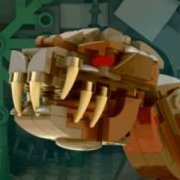
[LEGO IDEAS] Japan 🗾 Forest Fort (Extendable/opening)
MasterStud posted a topic in LEGO Historic Themes
Link: https://ideas.lego.com/projects/2948b9f0-6132-4243-bf62-dda71a111ab8 Wanted to make a set based on japan that would include a section of a forest as well as some buildings. While having cliffs that could open up and have more of a display/play area in the process. Tried to cram as many details as I could to generate a certain feel to the set. While trying to make the trees in a new realistic way so they stand out. Front view with the characters: Opened View: Tree and ground that's accessed at the center when it's opened. The front of the design. With the stonepath staircase, waterways and waterfall. Marketplace The big statue on the bottom level can be turned. Back of the cave system below the building: Roof: Side view: Kitchen Room (above the cave) Samurai Armour Room (Above the Kitchen) Roof Room: Statues: Characters, some are fantastical like the short Nuppeppo (folklore creature) and the Samurai guardian: Thanks for viewing, let me know what you think. -
Gotta get back, back to the past... Samurai Jack! Armed with a magic sword, a heroic samurai warrior sets out to defeat the evil demon sorcerer Aku. However, Aku transports him into the distant future, where the residents name him "Jack". Now Samurai Jack must find a way to return home to the past and obliterate Aku once and for all! Don't forget your hat, Jack! "Who dares to summon I, Aku?!" Using all the pieces to make his main form, Aku can "shape-shift" by being rebuilt into a scorpion... …or even a winged creature! Summary of Aku's rebuildable forms. What do you think of my product idea? If you have any feedback or suggestions regarding what you'd like me to improve or add to my project (bonus forms for Aku, supporting characters, enemies, etc.), I'm more than happy to take them into consideration! Link to my Product Idea
- 10 replies
-
- cartoon network
- japan
- (and 12 more)
-
I ve being thinking for a while to share with you my Lego Ideas Mocs... and I ve being hesitant. Well I decided to go ahead and do it!!! These is my latest moc and I m planning to upload the others too :) https://ideas.lego.com/content/project/link/3c993b46-9c04-400b-a633-86dd613463cc Based on several Japanese Traditional Watermills, this modular structure works both manually or with added Power Functions. It is made from 2073 Lego bricks, 3 minifigures and PF are also included in the count. When I began my research into Japanese Traditional Architecture I became fascinated with its Watermills... Such simple structures but at the same time so intriguing mechanisms that perform a simple task of grinding! My Working Watermill With Interior & Power Functions consists of the roof, a ground floor and a basement. The big Mill turns either by turning the crank on the rock in the river or by power functions that can be added in the basement. It creates movement in the mechanism found on the ground floor. If PF are not added the basement works as a storage for the seeds that are harvested and awaiting to be grinded. This would make a great set as I feel a working watermill is something missing from Lego sets. Its is very playful and could be easily added in a modular landscape. I m currently in the process of gathering bricks and hopefully before the end of the year I will be able to make it a real-life model! I would like to thank my dear friend @Patgeo for helping me work out and simplify the gears and power function mechanism!!!
-
Considering the amount of western licenses that Lego is managing, I am wondering how difficult and expensive it would be to acquire Japanese ones. The potential profits could be huge, in relation to both high number and dedication of manga and anime enthusiasts. City and sci-fi sets for Dragon Ball, pirates ones for One Piece, ninja style ones for Naruto. Personally I would like to see Macross and some classic Go Nagai robots. Anyway the dream - and perhaps most profitable - partnership would be with Nintendo and the endless possibilities offered by its IPs lore. I think of a Mario kart theme, a Zelda castles-fantasy line, a Pokemon one on the model of Brickheadz. Remembering the Amiibo crazy collecting phenomenon, a hypothetical Nintendo license would probably pay for itself in a short time with a handful of minifigures series. Lego if you are reading, please think about it!
- 17 replies
-
- japan
- franchises
-
(and 2 more)
Tagged with:
-
I wanted to build a geisha in vibrant kimono, and an another samurai character to accompany her. A tea ceremony scene felt natural way to do it. It was going to take place in a tea house or a pavillion at first, but as I didn't have parts for the walls in this scale, I changed the setting into a garden. The geisha also became a maiko, an apprentice geisha, as they wear more detailed attire. Vibrant and rugged colour scheme and details on two different sides of the creation reflect the character's nature and class; the maiko is surrounded by flowers, and the samurai's swords rest on the rocks beside him. More pictures and talk on my blog.
-
Hello! I'm happy to present you MOC about Japanese history! The Battle of Nagashino (長篠の戦い Nagashino no Tatakai) took place in 1575 near Nagashino Castle on the plain of Shitarabara in the Mikawa Province of Japan. Takeda Katsuyori attacked the castle when Okudaira Sadamasa rejoined the Tokugawa, and when his original plot with Oga Yashiro for taking Okazaki Castle, the capital of Mikawa, was discovered. Nobunaga's skillful use of firearms to defeat Takeda's cavalry tactics is often cited as a turning point in Japanese warfare; many cite it as the first "modern" Japanese battle. Seeking to protect his arquebusiers, which he would later become famous for, Nobunaga built a number of wooden palisades in a zig-zag pattern, setting up his gunners to attack the Takeda cavalry in volleys. Forces of Oda Nobunaga and Tokugawa Ieyasu. Forces of Takeda Katsuyori. Thanks for watching!
-
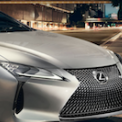
Stanced Porsche 911 GT3 RS
StudRobotics posted a topic in LEGO Technic, Mindstorms, Model Team and Scale Modeling
This is the second mod I have done to Lego's 42056 Porsche 911 GT3 RS set. I used the same height lift as I used on my previous Porsche mod and moved forward the bottom arms in the front and the rear of the chassis to add negative camber. The car was able to roll without the body on, but once I put it on, it couldn't roll. This means the car is now purely a display model. As much as a JDM fanboy I am, I'm kind of upset with the result of the car not moving, but at least I'm glad that I stanced this car anyways just for the fun of it. Although, quote automotive YouTuber GasKings, the camber angle does seem a bit too much on here like "a baby giraffe taking its first steps." So, what do you think of this mod I have done? Is it CamberGang worthy? I think it looks neat, but I would like to get rid of the camber (and the height lift) so I can roll this car around again. Here's some more pictures of the car I took. Thanks as always for checking this out, and I hope you'll stick around for my next builds. -
The Takehito Yamato Coupé I saw this classic Hot Rod on Chop & Roll magazine few months ago and I was stricken by the uncommon colour (PPG 1936 Cordoba Tan) and by the smooth design of this Deuce. Plus its story was really cool: built in California and shipped to Japan where its new owner lives. Japan has a thriving hot rod scene, and many cars have been bought and shipped there. This coupe, however, is the first being built to order then making the trek across the Pacific. Takehito Yamato contacted Walden Speed Shop, based in Pomona Ca., after seeing his works in The Rodder’s Journal. Takehito wanted a traditional hot rod, and while that may be essentially what he ended up with, the details are what really sets this coupe apart. Inspired by the Takehito Yamato history I built the tan Deuce with all the details you’d expect to see in a brick-built scale model. To complete the work I built a brand-new show-room full of vintage stuff. Below the broken-down view showing the red Chevy ZZ383 with aluminium heads in all its glory. Below the Deuce with the magazine where I read about its story. More info and pictures on my flickr Thanks for stopping by.
-
The last samurai of the old rule is challenged by the warrior of The New Shogunate. This was built for a Finnish LUG contest with the theme "The new meets the old". I had wanted to build a samurai for some time now so this seemed like a good idea. The whole scene became a lot larger than I had intended - these are 30 cm (one foot) thall figures, so the environment needs to be big... More can be found on my blog Cyclopic Bricks.
-
Hello, id like to share my latest moc its 4 small scenes featuring some of the more traditional parts of Japanese culture, any feedback and suggestions would be great More images and a better description can be found here - https://ideas.lego.com/projects/19577b3f-6bb5-4103-8cd3-d5e1134c6878
-
I visited Kinkaku-ji a few times in Japan trips. I love this shining golden temple. Make the little creation using LDD rendering tech. for whom love Japan , Kinkaku-ji and Kyoto. Builder : Alanboar Cheung Size : 6.5cm (L) x 13cm(W) x 6cm(H) Pieces : 300 pcs Flickr : http://www.flickr.com/photos/alanboar Creator : Alanboar http://lego.alanstudio.hk http://facebook.com/alanboar.creation
- 1 reply
-
- kinkaku-ji
- japan
-
(and 1 more)
Tagged with:
-
Hi! This is my first try to build a building. And sorry for my bad english. However, this is my version of a ancient japanese temple. What do you think? How can improve it? (It is builded on a 48x48 plate for 3k pieces)



